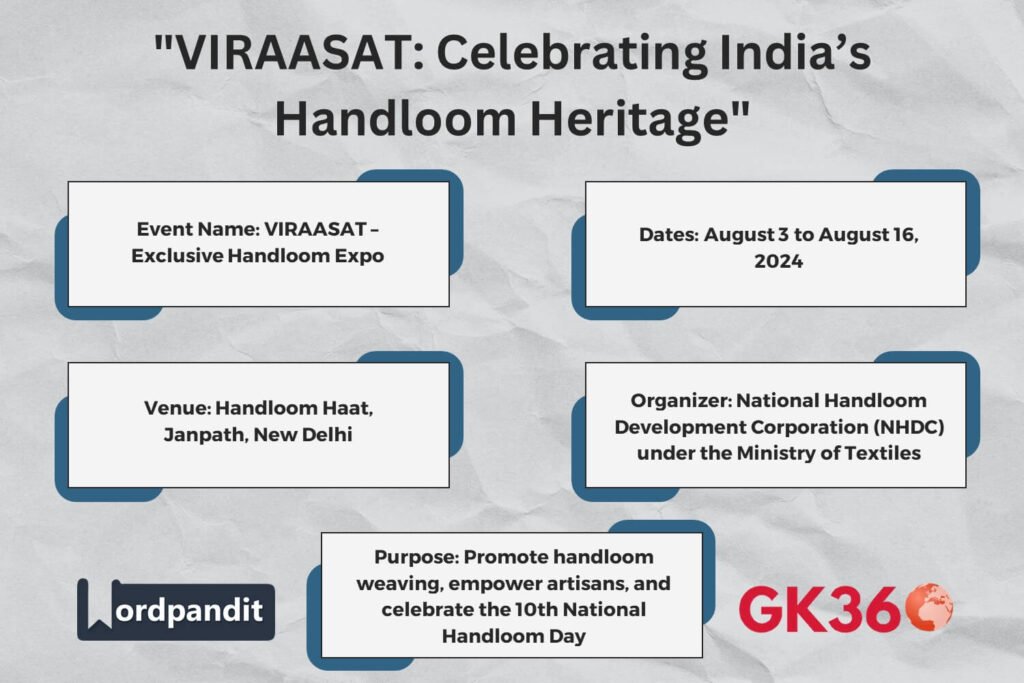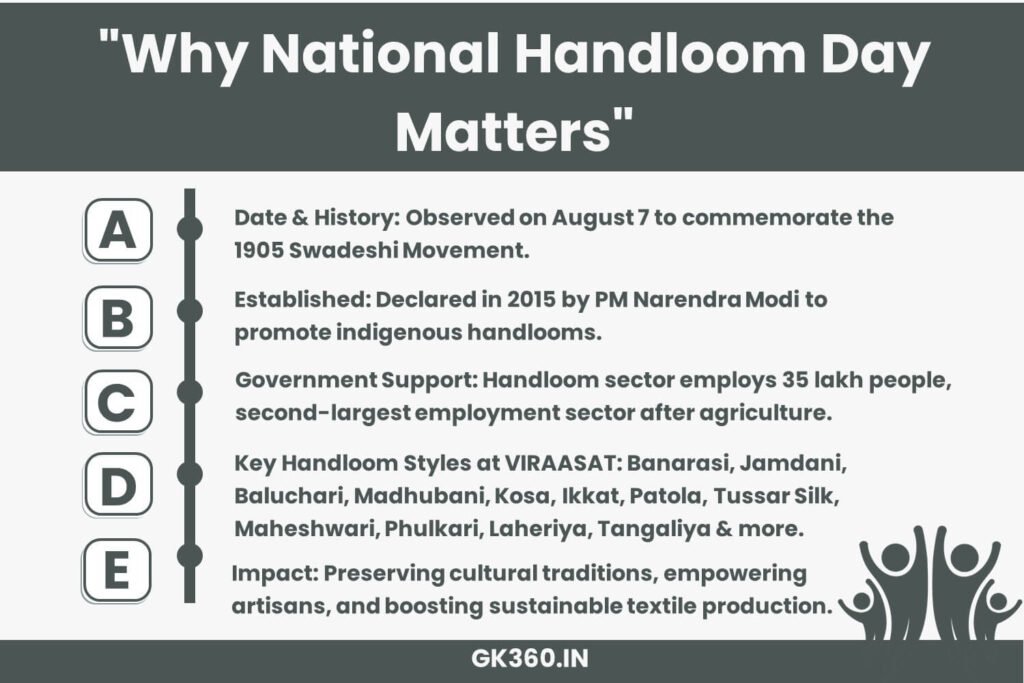VIRAASAT Exhibition Celebrates 10th National Handloom Day
Introduction
The “VIRAASAT” exhibition marks a significant celebration of India’s cultural heritage, coinciding with the 10th National Handloom Day. Held from August 3 to August 16, 2024, at Handloom Haat, Janpath, New Delhi, this event pays homage to India’s vibrant handloom traditions that have sustained the textile industry for centuries.
Organized by the National Handloom Development Corporation Ltd (NHDC) under the Ministry of Textiles, the exhibition is more than just a display of textiles—it is a celebration of artistry, history, and the weavers who continue to preserve this rich legacy.

Table of Contents
1. Event Overview
- Name: VIRAASAT – Exclusive Handloom Expo
- Dates: August 3 to August 16, 2024
- Venue: Handloom Haat, Janpath, New Delhi
- Organizer: National Handloom Development Corporation Ltd (NHDC) under the Ministry of Textiles, Government of India
- Purpose:
- To celebrate the 10th National Handloom Day.
- To promote handloom weaving and provide artisans a platform to showcase their craftsmanship.
- To support financial empowerment and sustainability in the handloom sector.
2. Significance of the Event
Historical Context
- August 7 was chosen as National Handloom Day to commemorate the Swadeshi Movement of 1905.
- This movement encouraged indigenous industries, particularly handloom weaving, to promote self-reliance and economic independence.
National Handloom Day
- Established on August 7, 2015, by Prime Minister Narendra Modi.
- Recognizes the contributions of handloom weavers and raises awareness about preserving India’s handloom heritage.
Government Support
- The Government of India actively supports the handloom sector through initiatives that provide financial assistance and promote sustainable development.
- The handloom industry is the second-largest employment sector after agriculture, engaging around 35 lakh people.
3. Showcasing India’s Handloom Diversity
The “VIRAASAT” exhibition showcases the diverse handloom traditions of India, giving visitors an opportunity to appreciate the variety and richness of handwoven textiles.
Key Handloom Products Featured:
- Banarasi, Jamdani, Baluchari, Madhubani, Kosa, Ikkat, Patola, Tussar Silk
- Maheshwari, Moirang Phee, Phulkari, Laheriya, Khandua, Tangaliya
Each textile represents a unique regional tradition, showcasing the intricate craftsmanship passed down through generations.

4. FAQs
Q1: What is the significance of National Handloom Day?
A: National Handloom Day, observed on August 7, commemorates the Swadeshi Movement of 1905 and promotes indigenous handloom industries.
Q2: What is the purpose of the VIRAASAT exhibition?
A: The exhibition aims to celebrate India’s handloom heritage, provide a platform for artisans, and promote financial empowerment in the sector.
Q3: Which handloom products are showcased at VIRAASAT?
A: The event features Banarasi, Jamdani, Baluchari, Madhubani, Kosa, Ikkat, Patola, Tussar Silk, Maheshwari, Moirang Phee, Phulkari, Laheriya, Khandua, Tangaliya, and more.
Q4: Who organizes the VIRAASAT exhibition?
A: The exhibition is organized by the National Handloom Development Corporation Ltd (NHDC) under the Ministry of Textiles, Government of India.
5. Conclusion
The “VIRAASAT” exhibition is not just a commercial expo but a celebration of India’s handloom heritage. It serves as a tribute to weavers and a reminder of the importance of preserving cultural traditions.
As we observe the 10th National Handloom Day, this exhibition stands as a testament to the resilience and creativity of Indian artisans. By engaging with and supporting the handloom sector, we ensure its continued growth and sustainability for future generations.
Key Takeaways Table
| Aspect | Details |
|---|---|
| Event Name | VIRAASAT – Exclusive Handloom Expo 2024. |
| Dates | August 3 – August 16, 2024. |
| Venue | Handloom Haat, Janpath, New Delhi. |
| Organized By | National Handloom Development Corporation (NHDC) under the Ministry of Textiles. |
| Significance | Celebrates 10th National Handloom Day, commemorating the Swadeshi Movement (1905). |
| Government Support | Handloom industry employs 35 lakh people, key sector for artisans. |
| Featured Handloom Styles | Banarasi, Jamdani, Baluchari, Madhubani, Kosa, Ikkat, Patola, Tussar Silk, Maheshwari, Phulkari, Laheriya, Tangaliya & more. |
| Purpose of Event | Promote handloom heritage, empower artisans, support financial sustainability. |
Related terms
- National Handloom Day 2024
- VIRAASAT Handloom Exhibition 2024
- Indian Handloom Heritage Celebration
- Ministry of Textiles Handloom Promotion
- NHDC Handloom Haat Janpath Expo
- Traditional Handloom Weaving in India
- Banarasi and Jamdani Handloom Sarees
- Handloom Sector Employment in India
- Sustainable Textile Industry India
- Swadeshi Movement and Handloom Legacy





